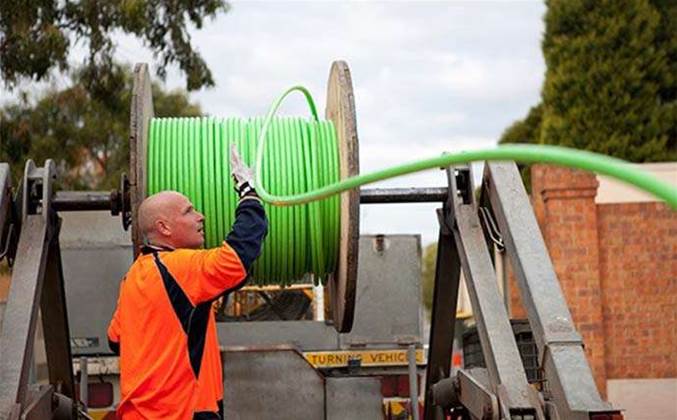NBN chief executive Bill Morrow has revealed the network builder’s board examined a fibre-to-the-distribution point rollout as a replacement to FTTN 12 months ago, with cost and rollout time considerations ultimately scotching the proposal.

The revelation was one of a number of contentious topics raised at an often heated senate committee hearing into the NBN today.
According to Morrow, NBN’s board initially expressed interest in a proposal to use FTTdp and “skinny fibre” technology for the network rollout as part of an annual strategic review process.
At the time of the discussions, there were uncertainties around the amount of work required on Telstra’s copper network, which has so far required $1 million in remediation.
However, the decision was ultimately put on ice by the board on the grounds the technology was still too “immature” and required further testing and development, Morrow said.
The board was also concerned it would have higher peak funding requirements and take longer to roll out than FTTN.
Sign up to the iTnews newsletter to keep on top of breaking news
“Each year, we brainstorm strategic alternatives. That’s where we said ‘let’s look at [FTTdp] in lieu of FTTN. It didn’t meet the criteria the first time, and it might not this time, but if it did in the future the board would be very supportive,” Morrow said.
In a heated exchange, Labor senator Stephen Conroy described the decision to opt for FTTN as “absolutely irresponsible”, claiming it was "extraordinary that the NBN board can continue to ignore this option”.
It was recently revealed NBN has trialled skinny fibre - which removes the need for the network builder to deploy fibre distribution cabinets - in parts of Ballarat, along with the southern Melbourne suburb of Karingal.
Morrow said more widespread deployments would be possible if the costs and rollout times fall below those for FTTN.
Over the longer term, he expected the thinner fibre would eventually be used to connect hundreds of thousands of premises, particularly in areas using long-length copper loops.
“When we combine skinny fibre with FTTdp, we see opportunities in unique areas that would otherwise be slated for fixed wireless or FTTN. Further, skinny fibre on its own may be well suited for new developments,” Morrow said.
“It is important to note there are trade-offs with skinny fibre, and it is still in development to some degree. This is a good example of our technology agnostic approach in finding the fastest way to deploy at the least possible cost.”
Cable causing delays?
Conroy also raised concerns NBN will not be able to meet targets for HFC deployment set out in its 2016 corporate plan [pdf].
The Labor senator claimed the HFC rollout had been nicknamed ‘Operation Clusterfuck’ internally.
Under the timeline, NBN is scheduled to have 10,000 premises ready for service by the end of financial year 2016, 2 million by FY17 and 2.35 million in FY18.
Morrow said NBN expected to finalise an agreement in the coming weeks that would see Telstra manage construction of the network in areas covered by its HFC network, following a memorandum of understanding late last year.
The network builder is hoping to get a “volume discount” with Telstra that would also see the incumbent telco oversee connections in the footprint area using other technologies, such as fibre-to-the-basement or fixed wireless.
In areas covered by both Telstra and Optus HFC networks, only the Telstra network would be used, although NBN will look at reusing existing Optus lead-ins where possible.
NBN has not yet signed a construction agreement covering the Optus HFC network outside a pilot area in Redlands, Queensland, and unlike Telstra, the Singtel-owned carrier will not take a role in HFC design.
The network builder currently has inventory of just 1000 DOCSIS 3.0 cable modems, with 17,000 more on order, while modems supporting DOCSIS 3.1 remain in testing.
Upgrades to the Optus HFC network include moving from having around 1200 to 1400 premises connected per node to around 600 to 700.
Conroy raised the possibility that a number of issues, including signing construction agreements, modem inventories and the amount of work necessary to upgrade the Optus HFC network could lead to a delay in the HFC rollout.
Late last year NBN revealed it was considering building over the Optus HFC network due to its degraded state.
“How are you going to get 2.35 million people on HFC in two years?” Conroy said.
Morrow said NBN had no firm commitments around delivering a particular number of customers on any given technology, and the network builder would deliver its top-line connection commitments.
He said there was some flexibility around which technology would be used to connect a given premises.



.png&h=140&w=231&c=1&s=0)
_(22).jpg&h=140&w=231&c=1&s=0)






 iTnews Executive Retreat - Security Leaders Edition
iTnews Executive Retreat - Security Leaders Edition












_(1).jpg&h=140&w=231&c=1&s=0)



